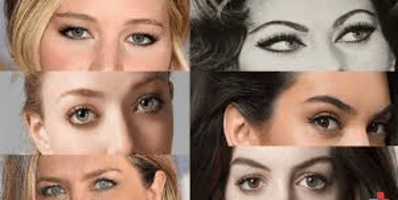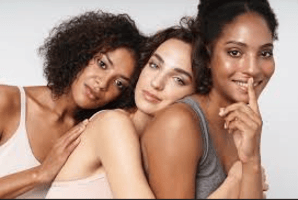Have you ever spent hours watching makeup tutorials only to realize the techniques don’t quite work for your eyes? The secret to stunning eye makeup begins with understanding your unique eye shape. What eye shape do I have? This question forms the foundation of personalized beauty routines that enhance your natural features rather than working against them.
Your eyes are as unique as your fingerprint, with subtle variations that influence how shadows, liners, and mascaras interact with your features.
In this comprehensive guide, we’ll explore the distinctive characteristics of various eye shapes, provide simple methods to determine your own eye shape at home, and offer tailored skincare and makeup recommendations that will help you see your eyes in a whole new light.

Understanding Eye Anatomy
Let’s establish some basic terminology that will help us identify the key features that define your unique eye shape:
Eyelid Crease: The fold where your eyelid meets the skin under your brow bone
Visible Lid Space: How much of your eyelid is visible while your eyes are open
Outer Corner: Where your upper and lower lash lines meet toward your temple
Inner Corner: Where your upper and lower lash lines meet toward your nose
Waterline: The moist rim of tissue between your eye and lashes
Orbital Bone: The bone that surrounds your eye socket
These anatomical features vary from person to person and contribute to the distinctive appearance of your eyes. These traits and the general shape of your eyes are influenced by a number of factors, including age, ethnicity, and genetics.
Primary Eye Shapes
The common eye shapes and their defining characteristics are:
Almond Eyes
Characteristics:
- Oval in shape with outer corners that are slightly upturned
- When the eyes are open, the lid space is visible
- The upper and lower lids may partially cover the iris.
- Crease is clearly defined
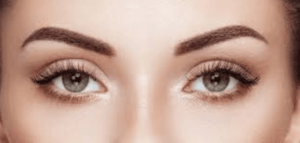
Almond eyes are often considered the ‘standard’ against which other eye shapes are measured in beauty contexts. If you have almond eyes, you likely notice that your iris disappears slightly beneath both your upper and lower lids, creating that distinctive almond appearance.
Round Eyes
Characteristics:
- Circular shape with prominent lid space
- Little to no disappearance of the iris under the lids
- When the eyes are open, the crease is noticeable
- Similar width and height proportions
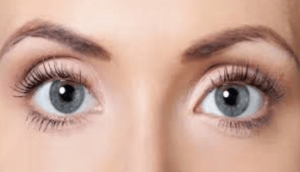
Round eyes appear large and expressive. If you have round eyes, you can usually see the whites of your eyes (sclera) above or below your iris when looking straight ahead.
Monolid Eyes
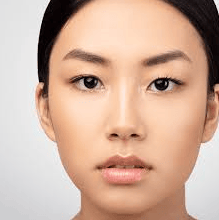 Characteristics:
Characteristics:
- Little to no visible crease on the eyelid
- Smooth appearance from lash line to brow
- Flat eyelid appearance when eyes are open
- Common in East Asian heritage
Monolids have a beautiful sleek appearance with minimal creasing. The absence of a defined crease creates a unique canvas for makeup application techniques.
Hooded Eyes
Characteristics:
- Extra skin folds from the brow bone that hang over the crease
- Limited visible lid space when eyes are open
- Crease may appear hidden
- It may be inherited or come with age.

Hooded eyes have a distinctive draping of skin that can partially or completely hide the natural crease. Many people with hooded eyes find that eyeshadow disappears when they open their eyes.
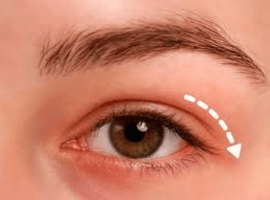 Downturned Eyes Characteristics:
Downturned Eyes Characteristics:
- Outer corners tilt downward
- Gives a naturally sweet, approachable appearance
- Lower lid may appear more prominent
- Often creates a slight drooping effect at the outer corners
If imaginary lines extending from the inner and outer corners of your eyes tilt downward toward your cheeks, you likely have downturned eyes.
Upturned Eyes
Characteristics:
- Outer corners tilt upward
- Creates a naturally lifted appearance
- Lower lid may appear shorter than upper lid
- Frequently explained as having a ‘cat-eye’ effect
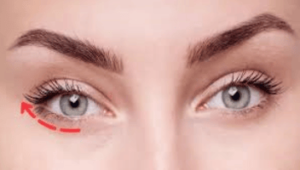
Upturned eyes create a naturally lifted appearance that many try to achieve with makeup techniques.
Deep-Set Eyes
Characteristics:
- Set deeper into the skull beneath the brow bone
- Pronounced brow ridge that casts shadow on lids
- Creates natural depth and dimension
- Crease may be well-defined but partially hidden by brow bone
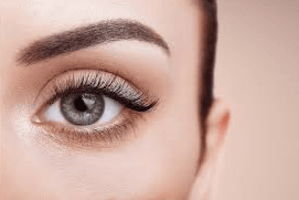
Deep-set eyes create dramatic shadows and depth, often appearing more recessed under the brow bone.
Protruding Eyes
Characteristics:
- Eyes appear to bulge outward from the face
- Substantial lid space visible
- Eyelids may seem fuller
- Globe of the eye extends past the orbital rim
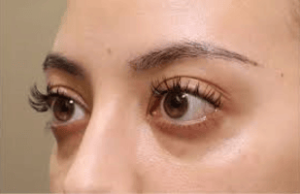
Protruding eyes, also called prominent eyes, stand out beyond the eye socket and create a bold, expressive look.
How to Determine Your Eye Shape
Here are a few techniques to help you identify your own eye shape:
The Mirror Test
Steps:
- Stand in front of a mirror at eye level
- Look straight ahead with a relaxed expression
- Observe the visibility of your crease, iris position, and corner angles
- Compare what you see with the descriptions above
The Photo Analysis
Steps:
- Take a clear, front-facing photo in natural light
- While looking straight at the camera without smiling
- Analyze the photo based on the characteristics described
- Consider taking side profile photos as well for additional perspective
The Makeup Test
Steps:
- Along your top lash line, apply a thin line of eyeliner.
- Raise your eyes and focus directly ahead.
- Note whether the line disappears, remains fully visible, or is partially visible
- This can help identify hooded vs. non-hooded eyes
The Crease Check
Steps:
- Look straight ahead in a mirror
- Determine if you can see your crease when your eyes are open
- Note whether the crease is visible, partially visible, or not visible at all
- This helps distinguish between monolid, hooded, and other eye shapes
The Corner Analysis
Steps:
- Draw a hypothetical horizontal line through your eye’s center.
- Note whether the outer corner tilts above or below this line
- Above indicates upturned eyes; below indicates downturned eyes
The Q-Tip Test
Steps:
- Hold a Q-tip horizontally against your eye, touching both corners
- If the outer corner sits higher than the inner corner, you have upturned eyes
- If the outer corner sits lower, you have downturned eyes
- If perfectly aligned, you likely have almond or round eyes
Remember that many people have combination eye shapes that incorporate elements from multiple categories. You might have primarily almond eyes with slightly hooded lids, or round eyes with a downturned outer corner.
Skincare Considerations for Different Eye Shapes
Your eye shape can influence specific skincare needs. Here’s how to adapt your routine based on your eye shape:
For Hooded Eyes
Skincare Focus:
- Use firming eye creams that target sagging skin
- Consider eye products with peptides to maintain elasticity
- Apply products before the hood deepens with age
- Be diligent about sun protection to prevent further sagging
For Deep-Set Eyes
Skincare Focus:
- Focus on brightening the undereye area to minimize shadows
- Use hydrating products to plump the skin around the eyes
- Consider light-reflecting eye creams
- Target any dark circles with vitamin C or niacinamide products
For Protruding Eyes
Skincare Focus:
- Use cooling eye products to reduce any puffiness
- Consider gel formulations rather than heavy creams
- Store eye products in the refrigerator for extra cooling benefits
- Use gentle pressure when applying products to avoid irritation
Essential Skincare Habits for All Eye Shapes
- Apply eye cream using your ring finger (the weakest finger) to avoid pulling delicate skin
- Pat, don’t rub, products into the skin around your eyes
- Extend sun protection to the eye area
- Remove eye makeup gently with appropriate removers
- Keep a healthy sleep routine and drink plenty of water.
Makeup Tips Based on Eye Shape
Let’s explore makeup techniques tailored to enhance your specific eye shape:
For Almond Eyes
Makeup Techniques:
- Most eyeshadow techniques work well with this versatile shape
- Emphasize the natural crease with medium-toned shadows
- Extend eyeliner slightly beyond the outer corner for a classic look
- Focus mascara on both upper and lower lashes
For Round Eyes
Makeup Techniques:
- Create the illusion of length by extending shadow and liner at outer corners
- Apply darker shadows to the outer third of the eye
- Keep the center of the lid light and bright
- Focus mascara on the outer lashes
For Monolid Eyes
Makeup Techniques:
- Create dimension with gradient eyeshadow application
- Use eyeliner to create the illusion of depth
- Apply thicker liner at the lash line, gradually thinning as you extend outward
- Consider tight-lining to define the eyes without taking up lid space
For Hooded Eyes
Makeup Techniques:
- Apply eyeshadow with eyes open to ensure placement is visible
- Focus darker colors above the crease where they’ll be visible
- Use waterproof formulas to prevent smudging
- Apply eyeliner very thinly and near the lash line.
For Downturned Eyes
Makeup Techniques:
- Focus darker shadow on the outer third of the lid, blending upward
- Wing eyeliner upward to counter the downward tilt
- Avoid applying dark colors to the lower lash line
- Curl lashes and apply mascara focusing on the center to outer lashes
For Upturned Eyes
Makeup Techniques:
- Balance the natural lift by focusing darker colors on the lower lash line
- Extend eyeshadow toward the inner corners
- Apply mascara evenly across all lashes
- Soften winged liner to avoid over-emphasizing the upturn
For Deep-Set Eyes
Makeup Techniques:
- Use light, reflective shades on the lid to bring eyes forward
- Avoid dark colors in the crease which can make eyes appear more recessed
- Apply highlighter to the center of the lid and inner corners
- Keep under-eye concealer light and brightening
For Protruding Eyes
Makeup Techniques:
- Use matte shadows to minimize prominence
- Apply darker shades on the lid and lighter shades on the brow bone
- Tight-line the upper lash line to define eyes without adding dimension
- Focus mascara on the roots of lashes rather than the tips
FAQs
How can I tell if I have hooded eyes or monolids?
Hooded eyes have a crease that’s partially or completely hidden by a fold of skin when eyes are open, while monolids have no visible crease at all. Look at your eyes in a mirror: if there’s a crease that disappears under a fold of skin when your eyes are open, you have hooded eyes. If there’s no crease at all, you have monolids.
Can eye shapes change with age?
Yes, eye shapes can change as we age. The skin around our eyes loses elasticity over time, which can cause hooding even if you didn’t have hooded eyes when younger. The fat pads under the eyes can also shift, creating changes in how deep-set or protruding your eyes appear.
Does eye shape affect vision?
Generally, eye shape doesn’t significantly affect vision quality. However, extremely hooded eyes might slightly restrict the upper visual field in some cases. Vision differences are more related to the shape of the eyeball itself (myopia, hyperopia, etc.) rather than the external appearance of the eye.
Is there a most common eye shape?
Almond eyes are often considered the most common eye shape globally, though this varies significantly by ethnicity. Monolids are more common in East Asian populations, while deep-set eyes are more common in those of European descent. It’s important to note that there’s tremendous variety within all ethnic groups.
Can makeup permanently change my eye shape?
Makeup cannot permanently change your eye shape, but it can create illusions that temporarily alter how your eyes appear. Consistent pulling on the eye area during makeup application or removal might contribute to sagging over time, so always be gentle with the delicate skin around your eyes.
Conclusion…
By now, you should have a much clearer understanding of your unique eye shape and how it influences your beauty routines. Remember that many people have combination eye shapes that don’t fit perfectly into a single category, and your eye shape may even change subtly as you age.
Embracing your natural eye shape is the first step toward developing skincare and makeup routines that truly enhance your unique features. Rather than fighting against your natural anatomy, work with it to highlight what makes your eyes special.
Let this guide be a starting point for exploration rather than a set of strict rules. Experiment with different techniques, adapt them to suit your preferences, and most importantly, have fun discovering what makes your eyes uniquely beautiful.

